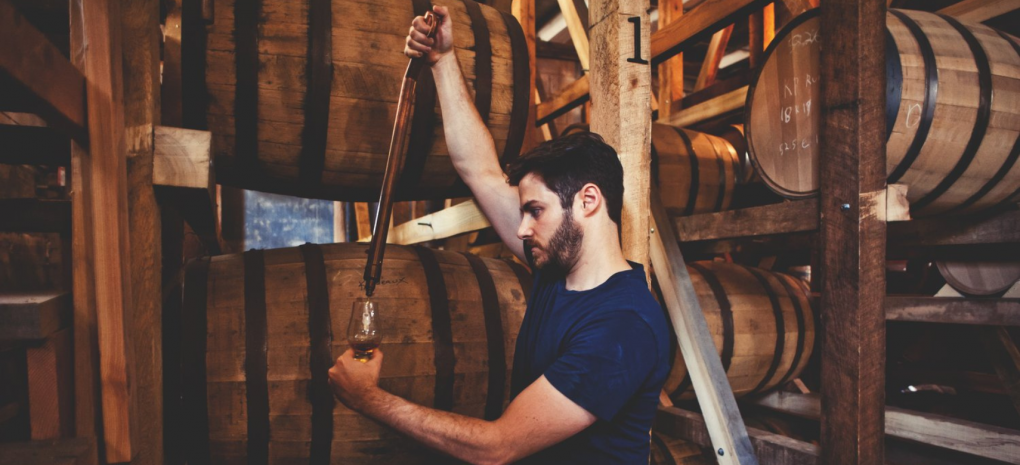
02/01/2024 Behind the Scenes of Distillery Operations with Ari Klafter, Head Distiller and Co-owner of Thornton Distilling Company and President of the Illinois Distillers Association.
In the world of craft distilleries, where artisanal spirits find their unique expressions, the role of a distiller encompasses far more than just crafting exceptional drinks. Ari Klafter, Head Distiller and Co-owner of Thornton Distilling Company wears many hats, balancing the intricate dance of production, management, and representation. In this insightful conversation, Klafter, who also serves as the President of the Illinois Distillers Association, shares his perspectives on the multifaceted responsibilities of a distiller, the critical elements driving profitability, and the evolving trends shaping the spirits industry.

Image: Sid Patel, CEO of USA Trade Tasting, and Ari Klafter, the head distiller and co-owner of Thornton Distilling Company, as well as the president of the Illinois Distillers Association.
Interviewer (Sid): Today, we’re talking to Ari Klafter, the head distiller and co-owner of Thornton Distilling Company, as well as the president of the Illinois Distillers Association. Ari, thanks for joining us. Can you start by giving us a brief introduction about yourself and your role?
Ari Klafter: Sure thing, Sid. I'm Ari Klafter, I’m head distiller and co-owner of Thornton Distilling Company. We produce a line of spirits called Dead Drop Spirits. My responsibilities include managing production, creating recipes, ensuring the efficiency of our distilling operations, working with distributors and private label clients, and representing the distillery in the public sphere at trade shows and through media outreach.
Sid: It sounds like you're involved in every aspect of the business. Being an owner must require a diverse skill set. Could you walk us through a typical day in the life of a distiller, especially one who is also an owner?
Ari: Absolutely, Sid. A typical day involves overseeing production, coming up with our recipes, and maintaining an efficient and functional distilling operation. I also liaise with distributors and private-label clients to keep our products moving. Additionally, I'm involved in the public-facing side of the business, attending trade shows, engaging in media outreach, and representing the distillery.
Sid: Given your multifaceted role, what are the top three things you believe a distillery must focus on to impact profitability and overall success?
Ari: For us, the front-of-house operations, including on-site sales, the bar, restaurant operations, and special events, are crucial. Our location, housed in the oldest standing brewery in Illinois, is a draw for events and weddings. It goes back 160-plus years. It's an old refurbished building. We put a lot of work into it, but a lot of it is original. That's the type of thing where people want to come in and enjoy that space.
Ensuring smooth operations in this area is a top priority. Distribution, bar, and events are all interconnected, creating a holistic approach to our business strategy.
People come in for a wedding, and they're coming from out of town or from the city of Chicago. They're going to say, this is a really interesting place. I want to come back.
And so they're going to come back and go to our bar. They're going to come back and buy a bottle of whiskey. Or they're going to say, I really like this product that I tasted while I was out there. Let me go and see if they have that on the store shelf. So they're going to go to the local Binnie's.
Similarly, it's important for us to make sure that we do get the right retail placements and also have very compelling and enjoyable products out there because people want to come. And so we're going to spend money at our cocktail bar and restaurant.
So it's pretty multi-faceted. But I would say making sure that that operation moves smoothly, is well prepared for the different seasonal cycles, and also has a good pipeline of special events.
Sid: What is your main focus from all of these aspects of the business?
Ari: Right now, I focus on the business. I focus a lot on actually creating a spirit inventory. So our main focus is American Single Malt, which we see as a growing category. It was always our intention to focus mostly on there. We do have whiskey that now has up to four years of age in our inventory. But we still haven't released that American Single Malt. We want it to actually be very mature by the time we release it. So my job each week is working with our production team to put down inventory. Making sure that we are distilling, we are filling barrels, we are putting barrels away in our warehouse. We are monitoring the maturity of those barrels, and seeing how they're coming along. And then we can eventually develop our different products from that inventory and start to create a pipeline for releases.
Sid: With your role spanning across various areas, how do you structure your team to manage these different aspects effectively?
Ari: Team structure is vital. We have managers in place who take ownership of different parts of the business—bar and restaurant operations, production, sales and distribution, and special events. Effective communication among these teams is key, especially during events, to ensure seamless coordination.
Sid: Moving into the production side, you mentioned a focus on American Single Malt. Can you elaborate on your challenges and considerations when creating and maintaining a spirit inventory?
Ari: Currently, we focus on American Single Malt, which is a growing category. Managing inventory involves working with the production team to ensure consistent distillation, filling barrels, monitoring maturation, and eventually creating a pipeline for product releases. It's a delicate balance between quality and timing.
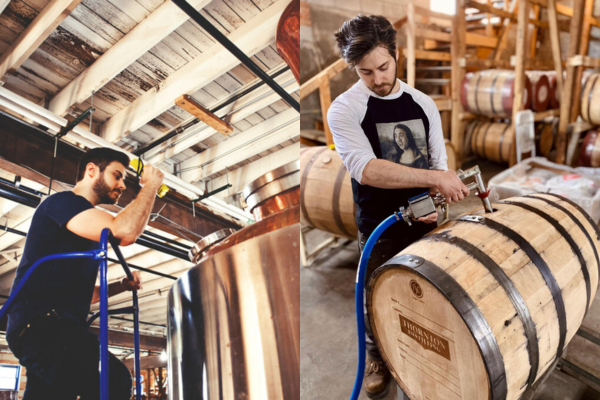
Image: Ari at Distillery
Sid: On the marketing side, you highlighted the importance of word of mouth and media outreach. Can you share specific strategies you've found effective in promoting the distillery and driving foot traffic?
Ari: Word of mouth and media outreach, especially through local news, have been impactful. Improving the customer experience at our bar and restaurant, incorporating historical aspects into tours, and engaging with consumers during events contribute to our success. Additionally, creating a mystique around our distillery's history and unique features has been a key strategy.
We are always looking to improve the customer experience at our bar and restaurant, whether that be bringing in new consultants to build out a new cocktail menu, building out new components in our kitchen, revising our kitchen menu, or putting together new portions of our tour. We are trying to actually fit in more tours so that we can show people not only the front of the house, the bar, and the restaurant, but also the historical aspects of our building as well as production, which tends to get a lot of very dedicated consumers.
So when people actually are really there to experience your place, not just as a bar and restaurant, but as a historic brewery and as a distillery, they can go to the Barrow Warehouse, taste things, and they can see the stills, that gets them really interested. And we're also able to see a lot of really good business conversions that way.
When somebody signs up for the tour, and then does a tasting with all of our products, they're much more likely to buy bottles.
I would say that has been really impactful.
Sid: How have you priced out your high-end tour, let’s say the VIP tour?
Ari: I think the tour is $15.
Sid: That's it?
Ari: Yeah. Because we see benefits with people becoming engaged.
Sid: So you'd rather have them pay less and sell a case later or a couple of bottles later than sell $40 and walk out?
Ari: Exactly.
So the thing I don't want to happen is for them to feel like they did not get their money's worth from the tour. We want them to feel like it was a great value, that they learned something new, and they're interested in our brand. That is exactly what we want. And even if they don't buy that bottle right then and there, then they're more likely to come back. They're going to come back, they're going to see our stuff on the store shelf, and they're going to buy it there.
So that is pretty important to us. We've worked to build out different tour slots, bringing on a new docent right now, somebody who can actually add more hours to the tour. We want to be able to free up some of the bandwidth of the person currently handling the tour, which is one of my other owners. So he can go out and do more sales.
Sid: What is the batch of your tour? How many people?
Ari: We can do up to 20 people. We keep it small. And trying to get 20 is still a big group. I feel like it's a pretty good number for a tour. If you get too many people, it doesn't feel personal. It's hard to actually keep track of everybody, which is not a good thing in a production environment.
You don't want people kind of doing their own thing. You want them to feel engaged and we want it to feel personalized. I'd rather us do more tours with fewer people.
Sid: When you're hiring that person who's going to do a tour, what kind of characteristics are you looking for? Are you looking for someone who can talk or has experience with distillation or spirits?
Ari: I would actually look for somebody who's really interested in history. And is good with engaging with people and reading a room.
Sid: So distilling knowledge is not required?
Ari: Distilling knowledge is important, but I think for the basics, we can train those people.
Sid: How long are the tours? In your experience what is an ideal duration for the tour?
Ari: I think it's a balance. And I think part of that is reading the room. Sometimes, I will give a tour, but I know the person is somebody who is deeply interested in this process. Maybe they're connecting with me, and they're going to come in and see the place because I invited them.
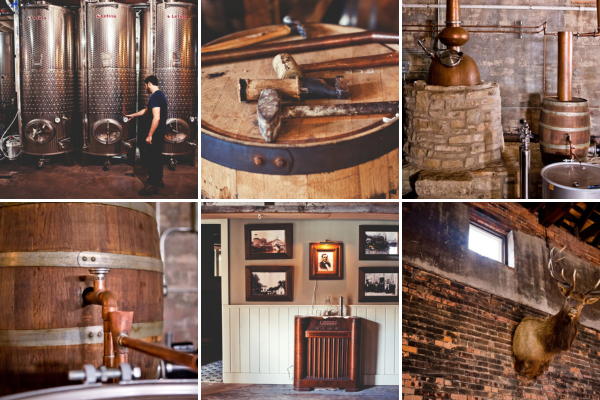
Image: Thornton Distilling Co. Tour with General Tours and Tastings
That's a little bit different than somebody signing up for our 1 o'clock tour and coming in. And they may be a group, but eventually they want to spend time at the bar. They want to get something to eat at the restaurant. They don't really want to be on a two-hour tour, but they don't want to be on a 15-minute tour either. So we tend to structure our tours around 40 minutes for something like that. For somebody who is really engaged, I absolutely love what I do. So when somebody starts talking to me about distilling and they want to know more and more about the process, I'll talk for hours. And that's great. You want people engaged like that.
But you also don't want to bore the people who are not really interested in that. There are a lot of people who want to focus more on the history of the building.
They want to focus a little bit more on trying the spirits. But they don't want to hear about different still setups, and different uses, these screens, and all that great technical stuff. And then you get some people that are not as interested in the historical aspect, but they're more interested in understanding how production is structured, why we do things the way that we do.
Sid: I want to talk more about marketing. You mentioned local media being effective. But on your on your premises, what kind of merchandising have you done? What kind of ticket sales?
How do you hand to sell? And if someone's coming in, how do you handle that? How do you upsell that tour or even introduce that tour? Like what are the tactics? What are the things that you guys do to greet a customer and then sort of sell them something?
Ari: I think first and foremost, when somebody comes in without having been there, we want them to have a pretty relaxed and casual experience at the bar. Understanding that in our area, there really are no upscale cocktail bars. There are places with very developed mixology programs. And the few places that there are, are very kind of fancy and expensive. We want this to be a little bit more relaxed.
From there, we want to remind anybody who comes in that we are a working production distillery. We'd love for them to get engaged with our products and feel free to sign up for a tour. One thing that's really interesting about our distillery is we have an artesian limestone filtered well where we get all of our processed water and it's actually underground. But when somebody's sitting at the bar, they can see the passageway down there. And it looks very striking. So we want that to be lit enough where it's not jarring but lit enough where it draws the person's eye and they'll ask the bartender, what's down there? And then the answer is like, that is our historic artesian well. And if you book the tour, you get to go check that out. So things like that, we want to create a mystique.
When we found the building, it was in a great state of disrepair. It took us about three years of construction before we could actually break ground, start doing production, and start having a bar operation. But in doing that we did not want to completely remodel the space. We wanted to keep it as true and historic as possible. It would be a shame to sort of take away the history of that space and make it very modern and contemporary. But also I think people can understand, they appreciate authenticity. So when they come and they see structures in there that have been there for generations, and they see that it used to be a brewery and here's where different pieces of equipment would have gone, that is, that very much resonates. And that helps reinforce our brand overall.
Sid: Looking ahead, what trends do you anticipate in the spirits industry for the coming years, and what challenges might distillers face?
Ari: One significant trend is the growth of American Single Malt whiskey. That has always been our main focus. I personally see that right now it is a very loose category and there are a lot of different interpretations, but I think that over time there will be a little more focus on the regionality within that category. I foresee a focus on regional distinctions within this category, emphasizing the unique terroir of different areas.
What does a Midwest single malt look and feel and taste like versus what a Pacific Northwest American single malt look, feel, and taste like?
How are different producers using the ingredients terroir, aging, and maturation conditions of their area to create interesting spirits?
A friend of mine is a head distiller at an American single malt distillery in the southwest and it is very hot and humid. And so they decided that it rapidly, pretty rapidly ages their whiskey, but also contributes to a ton of evaporation. They're better off using smaller barrels and trying to get their whiskey done pretty quickly rather than using larger barrels and
sitting on it and seeing a crazy amount of evaporation and a lot of a lot of spirit loss that way. It creates a very big, oaky whiskey. Whereas in colder environments like ours, I personally favor larger barrels, and more time, because we also think that the time in the barrel will impact the character of that whiskey, but also will allow us to put an age statement on our bottle and that value gets communicated to the customers. There are different things like that.
Additionally, there's a movement towards using local ingredients and exploring unique production methods, such as American peat.
Right now in the Midwest, we're sort of in the heartland in terms of grain production of the U.S. So we're seeing a lot of producers really hone in on that, whether they be farm distillers or they be like us, we're the first craft malt certified distillery in Illinois.
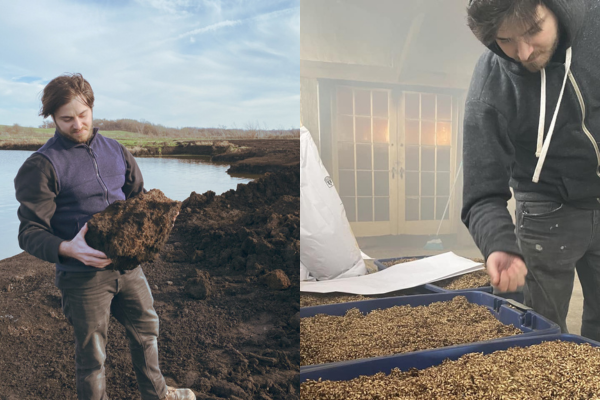
Image: Ari with peat and checking the grains.
I think a lot of distilleries in the American single malt category, will try to make the origin of their grains be part of their provenance. There are some distilleries that say that all of their whiskeys are made from only Colorado grains, grains sourced locally. I only use a small independent family-owned malt from a street nearby. So all of our grains are local. We're not going to be growing within a couple hundred miles of the distillery.
You are seeing subcategories coming up, varietals coming up more in American whiskey. And I also think you're going to see a little bit more use of American peat. That's something that, Westland was a big pioneer of that, using some of their Pacific Northwest peat.
We've been using Illinois peat as a huge part of our production. And I think there are going to be other pockets throughout the U.S. that find unique ways to use their own terroir.
Because otherwise, if they don't do that, they constantly all run up against this problem where they're being compared with Scotch single malt.
And what makes your products different or better than a 12, 15, 30-year Scotch? There's no good answer for that.
Unless you say clearly that the terroir is different, the grain is different. It's not that it's better, it's that it's different. The way that we do things is unique. It's unique from other distilleries in our area or in other parts of the U.S. as well. So I'd say that's important.
Challenges include distributor consolidation and the need for distillers to differentiate themselves in a market often compared to Scotch single malt.
I think we are seeing a lot of distributor consolidation at a time when there are a lot of new entrants. There are a lot of new clients. There are a lot of new producers coming together. And so that creates a little bit of tension.
We're finding producers that five, or ten years ago would have had no problem finding a meaningful distribution relationship, but now actually are having trouble getting some distributors to want to take them on because there are fewer distributors and their portfolios are already fairly large. That is something that is definitely a challenge.
Sid: Lastly, what do you see as potential threats in the industry, and how do you plan to navigate them?
Ari: The rise of Ready-to-Drink (RTD) beverages poses both a threat and an opportunity. While it may create challenges for some producers, there's potential for premiumization within the RTD market.
For certain producers, it's an opportunity. It really depends on what you're trying to make and who you are. Tequila and mezcals are on the rise and that's been great for a lot of people. A lot of people are focusing on those. But we've also seen a huge growth in whiskey just across the board. So I'm not saying that it's been a bad time for that either. I would say, it's been a good time for a lot of people.
I mean, depending on where RTDs go, it could be a threat or it could be a possibility. Like I was telling you earlier, I think there's going to be a lot of opportunity for premiumization in RTDs because, in the early years of RTDs, they've been very low proof, low cost, focused especially towards the early part of it, mostly malt-based. Now we're seeing more spirits-based RTDs. There's a little bit of premiumization in that space. Because if you have a seltzer that can be marketed either as a seltzer or as a vodka soda, it commands a different price point.
Producers may focus on using high-quality ingredients, exploring unique twists on classic cocktails, and differentiating themselves through natural and regional elements.
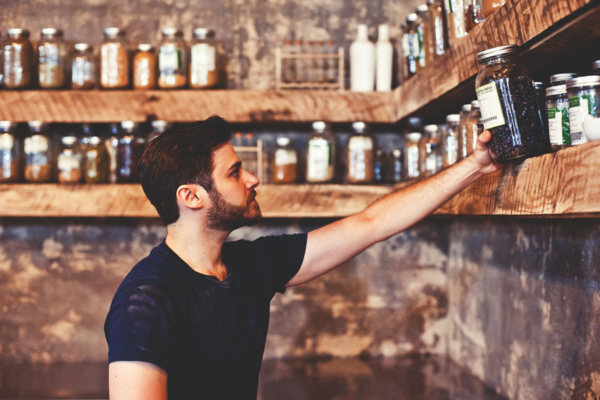
Image: Ari looking at the ingredients.
I think you'll see more high-end ingredients being put into RTDs and more premiumization. You're seeing a lot of people lean into classic cocktails.
Instead of having a lower-proof canned cocktail, you're seeing more 375s, more 750s. Higher proof, people using more, better quality ingredients, and also focusing on cocktail classics.
Even within that, I think there are a lot of people who are going to focus a little bit more on unique twists on cocktail classics. If you take the martini I was working on pretty recently, it is a Japanese gin-style base with a yuzu spritz. Things like that would be different.
One of our best sellers for the past couple of years has been our bottled Old Fashioned, which we have only in a 375 at the moment. One thing that we do differently is caramelize Demerara sugar on an open flame. We try to bring out the flavor of the sugar, but it's not very high over the high flame kettle to bring out the really deep flavors, which is quite labor intensive. We use Tahitian and Madagascar vanilla instead of an extract that you would find or get from a flavor house. I think that more and more you're going to see producers, particularly small, but also large, trying to use more natural ingredients, making the RTD market a little more premium.
Sid: Thank you, Ari, for sharing insights into the world of distilling and the intricacies of running a successful distillery. It's clear that your hands-on approach and strategic vision contribute to the unique identity of Thornton Distilling Company.
Ari: Thank you, Sid. It's been a pleasure discussing the nuances of the industry and our distillery's journey. Cheers!
[[relatedPurchasesItems-31]]
Conclusion:
Ari Klafter's narrative not only reveals the intricate details of managing a craft distillery but also highlights the pivotal role of on-site operations, the art of crafting distinct spirits, and the dynamic challenges in a rapidly evolving industry. As the landscape of artisanal spirits continues to shift, Klafter's insights serve as a valuable compass, guiding both enthusiasts and industry professionals through the complex and flavorful world of craft distillation.



